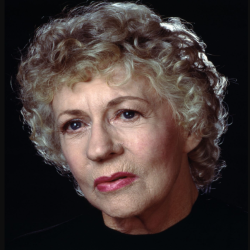
Uta Hagen
| Date of Birth | : | 12 Jun, 1919 |
| Date of Death | : | 14 Jan, 2004 |
| Place of Birth | : | Göttingen, Germany |
| Profession | : | Actress |
| Nationality | : | German, American |
Uta Thyra Hagen was a German-American actress and theatre practitioner. She originated the role of Martha in the 1962 Broadway premiere of Who's Afraid of Virginia Woolf? by Edward Albee, who called her "a profoundly truthful actress."
Biography
Hagen’s family moved to the U.S. when she was seven. After studying for a short time at the Royal Academy of Dramatic Art in London and then at the University of Wisconsin, she made her professional debut when she was 18 in Eva Le Gallienne’s production of Hamlet. Hagen made her Broadway debut in 1938 as Nina in The Seagull, a production that starred Alfred Lunt and Lynn Fontanne. That same year Hagen performed opposite José Ferrer in The Latitude of Love. Hagen and Ferrer were later married, and over the 10 years of their marriage, they acted together in several productions.
In 1947 Hagen appeared in The Whole World Over along with Herbert Berghof, whom she married in 1951. The two founded and began teaching at the Herbert Berghof Studio (known as the HB Studio) in New York City’s Greenwich Village; it became one of the city’s best performing arts schools. In 1948 Hagen starred as Blanche DuBois in the road company production of A Streetcar Named Desire and then took over the role on Broadway, and in 1950 she appeared in the role for which she won her first Tony, Georgie in Clifford Odets’s The Country Girl.
Hagen was blacklisted in the 1950s but made her stage comeback in Who’s Afraid of Virginia Woolf? (1962). She also traveled with that play to London—winning the Drama Critics Award. In 1999 Hagen was honoured with her third Tony Award, this one for lifetime achievement. In addition, Hagen wrote the acting textbooks Respect for Acting (1973) and A Challenge for the Actor (1991).
Quotes
The knowledge that every day there is something more to learn, something higher to reach for, something new to make for others, makes each day infinitely precious
All tedious research is worth one inspired moment.
no work of art is ever finished, nothing is ever static, no performance is for keeps.
We must overcome the notion that we must be regular... it robs you of the chance to be extraordinary and leads you to the mediocre.
Theoretically, the actor ought to be more sound in mind and body than other people, since he learns to understand the psychological problems of human beings when putting his own passions, his loves, fears, and rages to work in the service of the characters he plays. He will learn to face himself, to hide nothing from himself- and to do so takes AN INSATIABLE CURIOSITY ABOUT THE HUMAN CONDITION
The actor must know that since he, himself, is the instrument, he must play on it to serve the character with the same effortless dexterity with which the violinist makes music on his. Just because he doesn't look like a violin is no reason to assume his techniques should be thought of as less difficult.
Talent is an amalgam of high sensitivity; easy vulnerability; high sensory equipment (seeing, hearing, touching, smelling, tasting intensely); a vivid imagination as well as a grip on reality; the desire to communicate one's own experience and sensations, to make one's self heard and seen.
To rebel or revolt against the status quo is in the very nature of an artist.
Since the time of the ancient Greeks a democracy has depended on its philosophers and creative artists. It can only flourish by continuous probing, prodding, and questioning of the social conditions under which man exists and tries to better himself. One of the first moves of a dictatorship is to stifle the artists and thinkers who have the ability to stir up dissent from any prescribed dogma which might enslave them. Because the artist can arouse the curiosity and conscience of his community, he becomes a threat to those who have taken power.
Thoughts and feelings are suspended in a vacuum unless they instigate and feed the selected actions, and it is the characters actions which reveal the character in the play.
